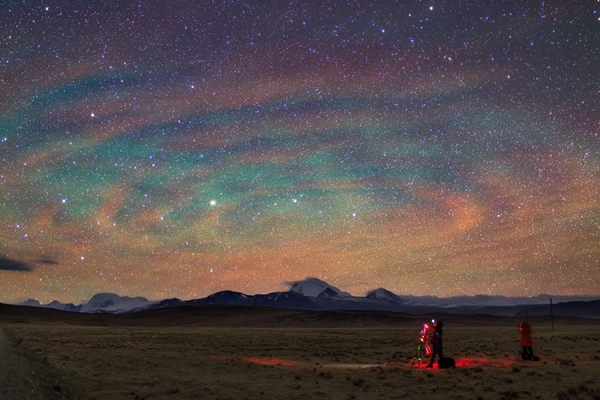Shooting for the stars

Airglow rippling over the Himalayas, taken on April 27, 2014.[DAI JIANFENG/CHINA DAILY]
'Universe Boy' wins photo honors from NASA, magazines and websites
Dai Jianfeng took four years to complete his transformation from automobile engineer to astronomy photographer.
His stunning work has been published on the websites of NASA, the Proceedings of the National Academy of Sciences in the United States, and other international media sites dedicated to space and astronomy. A Japanese website even dubbed him "Universe Boy" in a story about his photos.
"Shooting the starry night is not only about the artistic beauty in photography, but also about the implementation of astronomy, geology, history, culture and meteorology," Dai said. "Sometimes, you risk your life."
NASA has published four of Dai's images online, under his English byline, Jeff Dai, as its "Astronomy Picture of the Day", including a recent photo depicting a colorful solar corona over the Himalayas.
Another shot, an image of a starry night sky over the Himalayas taken in 2014 graced the cover of the Dec 8 issue of PNAS, the official journal of the US National Academy of Sciences. The photo taken from the Tibetan Plateau showed gravity waves "revealed in a thin layer of glowing atmosphere called airglow".
"The orange colors come from excited hydroxyl radicals, and the green colors from oxygen light emissions," the journal explained. "In the foreground are the Himalayas, and astronomy photographers capturing the night sky."
Scientists from NASA and the US National Oceanic and Atmospheric Administration captured the same starry sky from space with the help of satellites, so Dai's photo provided "precious synchronous data" observed from the ground, the journal said.
The 27-year-old, soft-spoken Dai was born in China's southwestern municipality of Chongqing. In a mega city of nearly 30 million people, light pollution obscures the upper atmosphere and his childhood memories do not include a starry sky.
After graduating from Chongqing University in 2011, Dai became an automobile engineer and played video games in his free time. However, a weekend stargazing trip to Mount Fanjing in nearby Guizhou province changed everything. He fell in love with astronomy, and set out to record beautiful moments of light in the dark.
In August 2012, he published his first photo in Astronomy, a US monthly magazine. Shot in Southwest China's Yunnan province, the photo shows the Milky Way at moonrise.
On another shoot, he almost got lost when crossing a glacier. And he was once chased by nine wild dogs in the Tibet autonomous region at midnight.
On his birthday in May, Dai decided to quit his job and became a freelance photographer. "A sense of mission and responsibility has grown in me as I have shot the stars," he said. "I have recorded so many beautiful scenes of the night sky that no one has seen and I should share them with other people."
Wang Xiaohua, general secretary of the night sky working committee at the China Biodiversity Conservation and Green Development Foundation, said Dai is an outstanding photographer who also is keen on dark-sky preserves.
"Dai extends his love of starry nights to protection of dark skies, and he uses his own photos to call people's attention to them," said Wang, an activist for dark-sky protection in China, who works for the Chinese branch of the International Dark-Sky Association.
In July, when Wang was promoting dark-sky protection in Lhasa, the capital of Tibet, he and Dai met, hit it off and became friends. Wang told Dai that the association needed photos of starry nights in Tibet's Ngari prefecture, but could not pay him. Dai took them anyway, and in August they were presented at the 29th general assembly of the International Astronomical Union in Honolulu to promote China's first Dark-Sky Reserve in Ngari.
"The best dark-sky regions are all located in remote regions. Dai's photos give more people the chance to see the beautiful nights there, and to become aware of the importance of protecting them," Wang said.
Dai plans to shoot photos of the entire Himalaya range. "The south and north sides of the Himalayas, though different in geography, culture and religion, share the same sky," he said. "In space, we have no national differences. I want to communicate that to others through my photos."
Your Comment
Name E-mailRelated News
-
;
-
-
Travel tips: Adapting to high altitude step by step
Experts suggest that people, especially the first-time visitors, should reach Tibet step by step in order to acclimatize themselves to the rise of altitude.
-
-
-

-
Best travel time in Sichuan Tibetan-inhabited area: Uncrowded and
After the International Labor day on May 1, and before summer vacation, the amount of travelers experienced a slight drop, and the travel costs fell slightly as well. It provides tourists with the perfect opportunity for travel.
-
-
-
Travel tips:Food,Clothing,and Shopping
For those out there who are traveling to Tibet for the first time, we recommend that you choose to stay in a three-star hotel near the Potala Palace.
-
Based in Lhasa, Tibet Vista is a Tibet travel agency that specialized in Tibet permit, and Tibet tours for both private and group travelers at a local price!
•4 Days Lhasa City Group Tour from USD 460 •8 Days Everest Base Camp Group Tour from USD 850 •15 Days Mt.Kailash Group Tour from USD 1780 •2016 Tibet Train Tours from Beijing, Shanghai, Chengdu, Xining,etc










